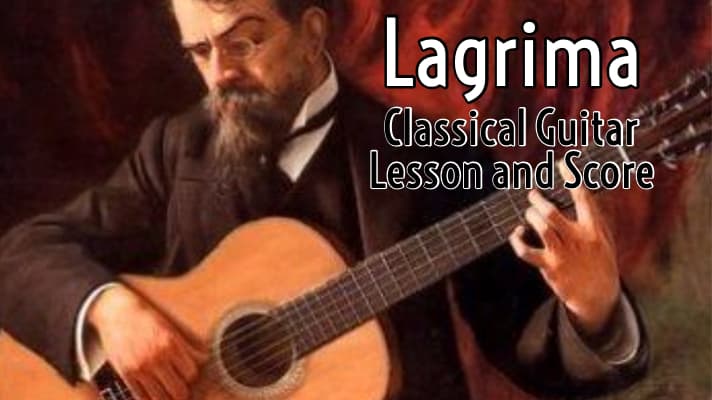My first (online) Classical Guitar Lesson! I gotta say, I’m kinda stoked about it too. If you’ve read my 2019 Guitar Goals article, you know that classical guitar is a beloved hobby of mine and something I always strive to improve.
In this Lesson:
- Intro
- Francisco Tarrega
- Intro to Classical Guitar
- Score Analysis
- Tips For Practicing
- Video Performance
January for us working musicians in Florida can be the slowest time of year for live gigs. Even though I have over 20 gigs on the schedule this month.. I’ve still made some time to work on my classical guitar repertoire.
If you’re new to classical guitar playing in general or are just looking to give it try.. let me say with enthusiasm… Just Do it! Classical guitar can be so rewarding for players of any skill level and it will make everything you do on the guitar better, regardless of your main style of playing. I do mean everything…
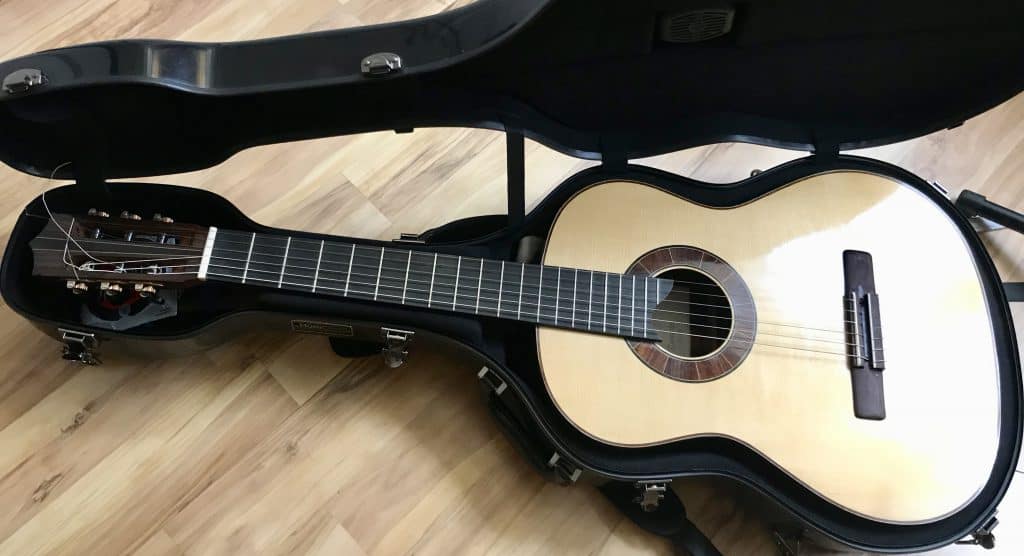
My Custom Made David Gohara Guitar
When I get into a good, regular classical guitar practice routine, both of my hands feel so balanced, strong and it translates into everything else I do on the guitar. The technical benefits may be obvious but the music and what you can take away from it will last a lifetime.
I chose Lagrima by famed Spanish guitarist and composer Francisco Tarrega as this lesson’s piece. I like Lagrima because it is easy enough for a beginner to get into while being challenging in some sections even for an advanced player. It’s also just a beautiful little piece of music. I hope you enjoy it as much as I do.
Let’s get to it!
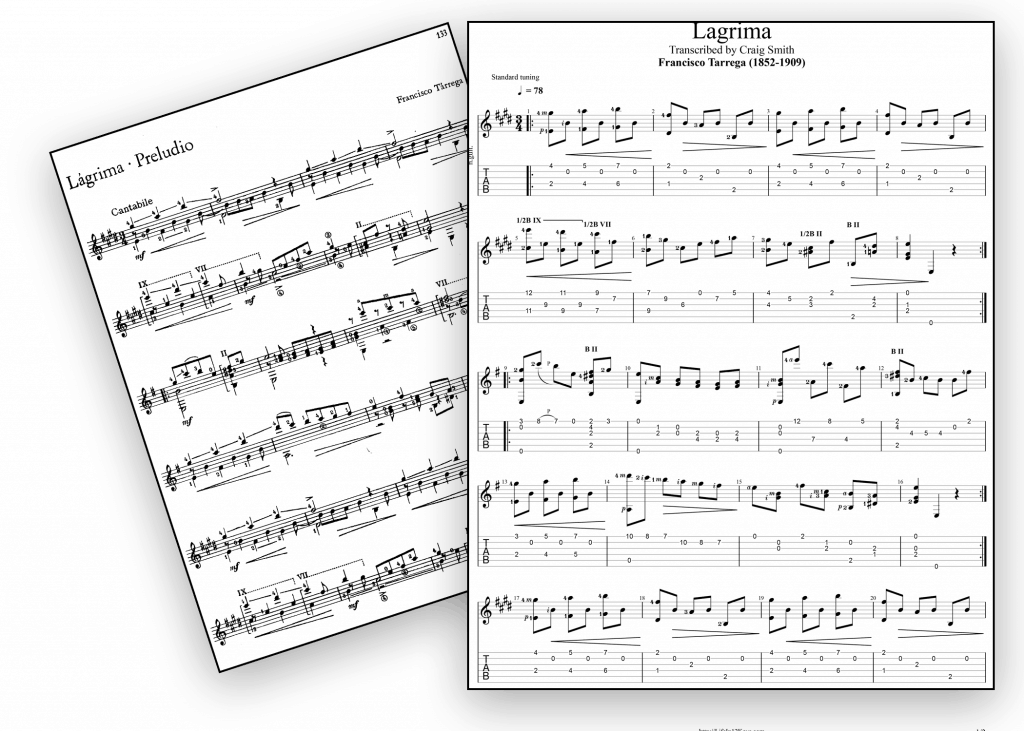 If you’re already comfortable with some classical guitar and want to skip the lesson and get right to it, you can download the full score from the FREE guitar printables page.
If you’re already comfortable with some classical guitar and want to skip the lesson and get right to it, you can download the full score from the FREE guitar printables page.
This download includes Tarrega’s original 19th century manuscript as well as my updated 2019 version (both in .PDF format) that includes left and right-hand fingerings in standard and TAB notation and Guitar Pro Audio file.
Francisco Tarrega
Francisco Tárrega (1852 – 1909) was a Spanish composer and classical guitarist. He has been called “the father of classical guitar” and is considered one of the greatest and most influential guitarists of all time.
Remember, Francisco Tarrega pre-dates the great Andres Segovia. I’ve read that Tárrega was going to give Segovia guitar lessons but he died before they could meet in 1909. Regardless, Segovia wore his Tarrega influence on his sleeve and performed most of his repertoire throughout his 70+ year professional performing career.
Back in 1881, Tárrega played performances in the Opera Theater in Lyon, France as well as the Paris Odeon Theater. This was a gig for the 200th anniversary of the death of Spanish writer and poet, Pedro Calderón de la Barca.
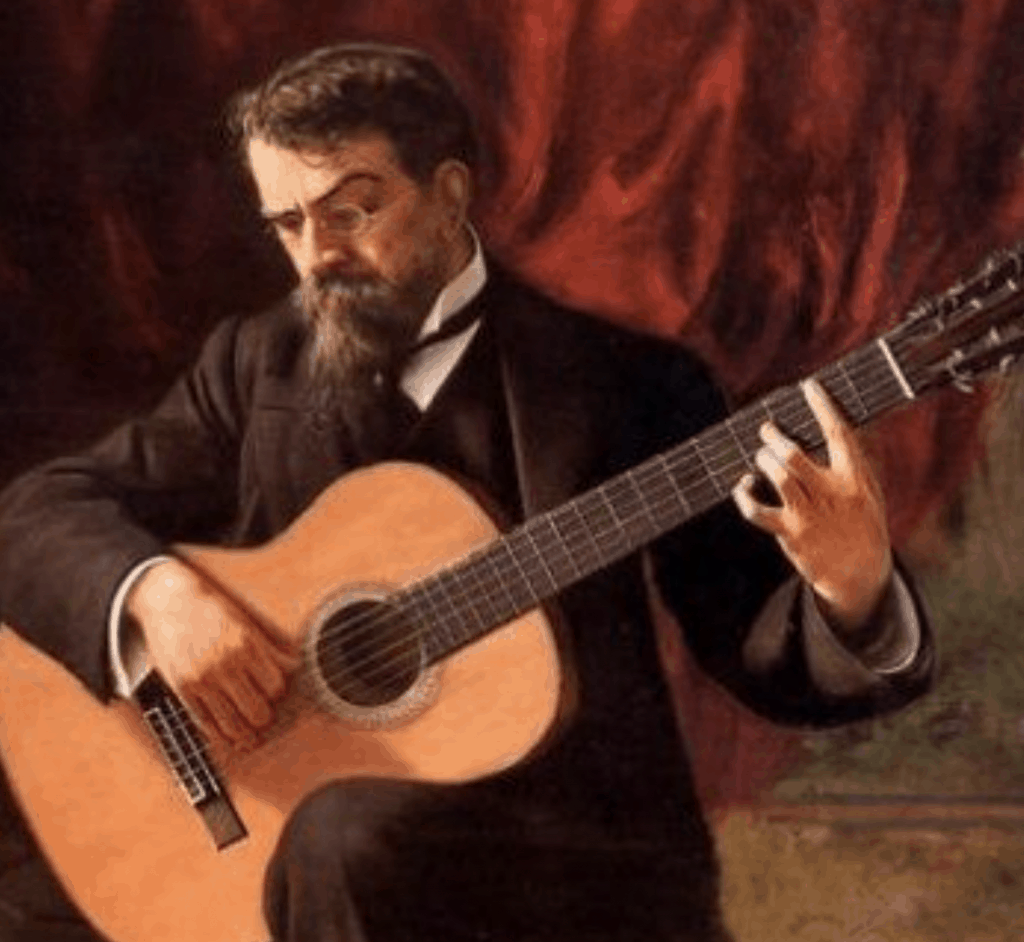
Tarrega also played in London, England that same year. It was said that he hated the language and the weather in England. After a London performance a fan noticed that the guitarist appeared sad.
The concertgoer asked “What’s the matter maestro?” “Do you miss your home or your family perhaps?” Tarrega did.. Life on the road isn’t for everyone, even in the 19th century.
The fan told Tarrega he should capture this sadness in his music… write about it. It was at that time that he wrote the main theme for one of his most memorable pieces, Lágrima (in Spanish, literally meaning “teardrop”).
In January 1906, he was afflicted with some type of paralysis on his right side, probably an undiagnosed stroke. He did return to performing briefly but never fully recovered. He finished his last composition, Oremus, on December 22nd of 1909. Tarrega died in Barcelona, Spain just thirteen days later at age 57.
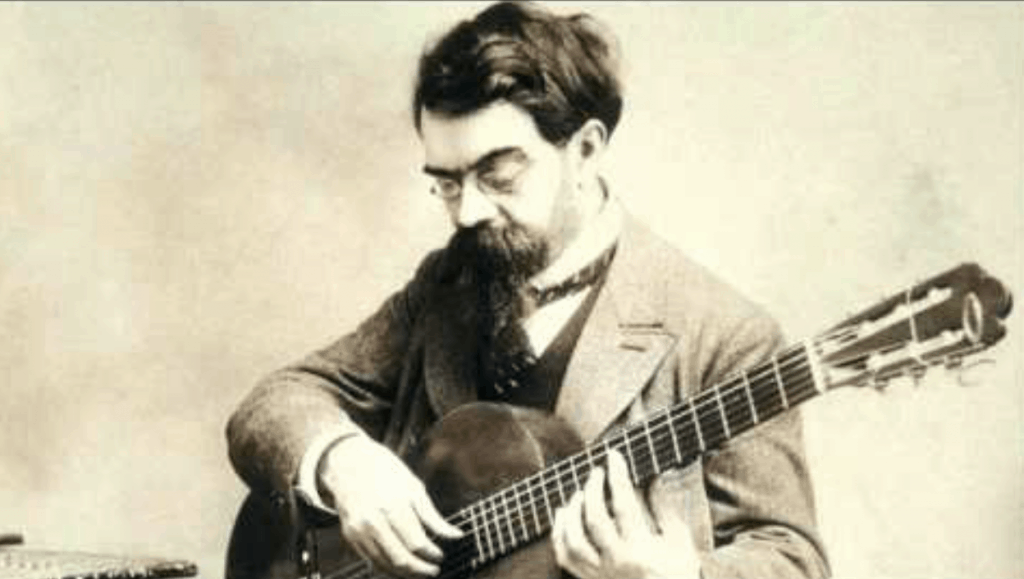
Classical Guitar 101
If you’re completely new to classical guitar playing and technique, let’s get a few of the basics out of the way. The main difference between classical and other styles of guitar playing is the use of the right hand fingers for picking.
In the score below you’ll see the letters: p i m a throughout. While the left hand fingers are numbered: 1 2 3 4, the right hand uses a lettering system.
- p – Thumb or pulgar.
- i – 1st finger or index.
- m – 2nd finger or middle.
- a – 3rd finger, ring finger, annular.

While many famous classical guitarists used their finger tips to strike the strings, modern practice widely advocates the use of nails for better tone production. Do a quick google search on “classical guitar nails” to find more information on shape, size and filing.
Generally, a good starting point is to grow them about 1/16 to 1/8 of an inch past the finger tip and then file them smooth. I even like to use a super fine (2000 grit) sandpaper to finish them. I also will smooth them over with the sandpaper for a few seconds before each classical guitar practice session for better tone.
You can play classical guitar repertoire on any guitar, but I’d highly recommend a nylon string, “Spanish” style guitar. Entry level guitars from Yamaha and Cordoba are relatively inexpensive and you’ll get the real experience!
Classical Guitar Scores
If you’re not comfortable with standard notation, I’ve included TAB in the score below. Tablature is not typically included in classical guitar scores but for the purposes of this lesson I figured, hey, why not? If it helps even one person learn to love this wonderful music, it’s worth the extra effort.
I’d highly encourage everyone to learn to read standard music… it’s not as hard as you think and in many ways is far superior to TAB notation. It’s also just a lot of fun.
Learning to read music is outside of the scope of this article, but there are a few books that can get you there better than I ever could. I’d highly recommend these 3 books which are inexpensive and great to have around:
- Music Reading For Guitar – G.I.T
- Berklee Guitar Books 1-3
- Sagreras’ Classical Guitar Method Books 1-3
The first steps when reading a new classical guitar score look something like this:
- Read through the score without a guitar.
- Is there anything on the page you don’t understand? If so, look them up. You can find any musical symbol or phrase on wikipedia.
- What is the Key Signature?
- What is the Time Signature?
- What is the tempo?
- Are there any repeats?
- Take note of barre chords (roman numerals that indicate position).
- Take note of left and right hand fingerings and make changes where necessary.
Lagrima Lesson
Guitar Pro Audio for reference-
Lets take a look at the first 4 bars of Lagrima:

Tempo is 78 bpm
78 bpm falls into the Andante zone, a tempo indicator – “at a walking pace” (76–108 bpm on your metronome)
Right away I see were have 4 sharps (#) indicating the key of E Major.
E F# G# A B C# D# E
Unless otherwise indicated by an accidental, the first section of this piece will utilize notes from the E Major scale exclusively. You can’t get that information from TAB!

You don’t have to memorize all of the notes in E Major all over the neck, but it is handy to make a mental note of where those notes lie on the fretboard. Now let’s look at the time signature in Lagrima:
- The time signature is 3/4.
- 3 beats in a measure.
- The quarter (1/4) note gets 1 beat.
In Lagrima, nothing is played “faster” than an 1/8 note so we could feel the piece counted as:
1 & 2 & 3 &
Dynamics
“In music, the dynamics of a piece is the variation in loudness between notes or phrases.”
The opening < indicates a crescendo – to get LOUDER.
The closing > indicates a decrescendo – to get softer.
So far so good?
Work through the first 4 measures slowly paying close attention to both left and right hand fingerings.
Lagrima Measures 5-8
Most guitarists would agree that measures 5-8 contain the trickiest spots in this piece. The hardest part is getting from the first position in measure #4 up to the 9th position smoothly in a 1/2 barre chord indicated by the roman number IX in measure 5:

Half-Barres
When you see a 1/2 barre it indicates exactly that. You only need to barre the top 3 strings to get the barre chord.
A good way to work through this section is to start on the last chord in measure 3 and work through the shifts to position 9 and the subsequent descending bar chords in measure 5. Do this in a loop, repeating as many times as necessary to get it comfortable.
Bar 6 eases up slightly with some non-barre shapes descending into the E Major resolve in bar 8. Again, pay close attention to the left hand fingering to get the best results when shifting through these chords.
Note the repeat sign in bar 8 indicating a repeat from the beginning of the piece back to the end of measure #8.
Lagrima measures 9-12
In measure 9 we have a big change! We’re switching from the key of E Major to E minor (G Major), 1 sharp (#).
E minor scale:
E F# G A B C D E

Notice the pull-off (slur) in measure 9.
Here the difficulty lies in measure 12, particularly the awkward barre in position 2. Other than that, it’s a relatively easy section.
Notice the notes on the neck change to use only notes in the E minor scale:

Lagrima measures 13-16
Measure 13 repeats a theme established in measure 1 but transposed to E minor.
Measure 14 includes a descending scale starting on the pinky D note. Another reason I love this piece. You really get a little introduction to so many useful classical guitar techniques, including scales.
Measures 15 and 16 are probably the second most difficult of the entire piece. Pay close attention to the left-hand fingerings and work through these 2 measures slowly until the ending chord forms can be transitioned through without mistakes.

Lagrima measures 17 thru 24 just repeat the first section one time. Yes! You did it. Nothing more to memorize. Now set that metronome to a slow pace and work through the whole piece gradually building up to the 78 bpm goal (or any desired “andante” tempo).


Tips For Practicing
- Memorize one measure at a time.
- Each time you add a measure, go back and play slowly through them all from the beginning of the piece.
- When you encounter trouble spots, slow it down even more and take note of every movement that is causing the problem.
Correct the problem and move on. - If a fingering is uncomfortable, change it! My fingerings are only suggestions that work best for ME.
You can download a FREE 3 page PDF mini-book of Tarrega’s original Lagrima score, the Guitar Pro audio and TAB file and also my own updated 2019 score that includes all fingerings and TAB notation.
Craig Smith is a professional Guitarist, Teacher, and Writer living in Sanford, Florida. Craig has taught guitar lessons, performed 200+ gigs per year for nearly 30 years, and published 4 guitar instructional books. When he’s not gigging or writing, you may find him by the pool with his wife Celeste, 4 Chihuahuas, and a drink. 🎸


